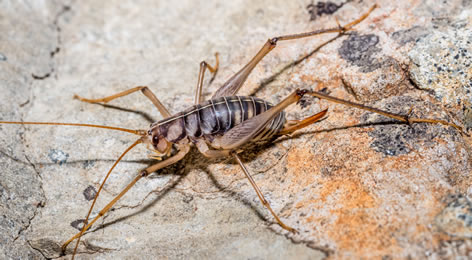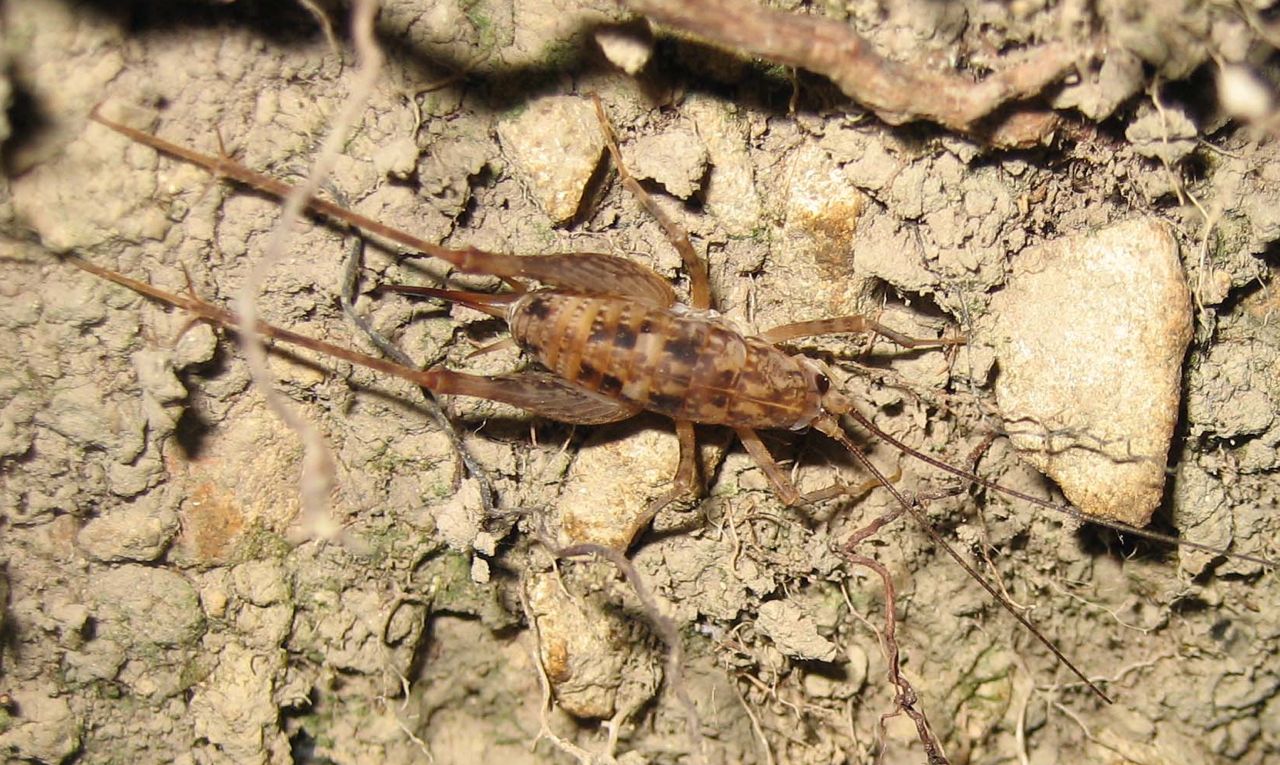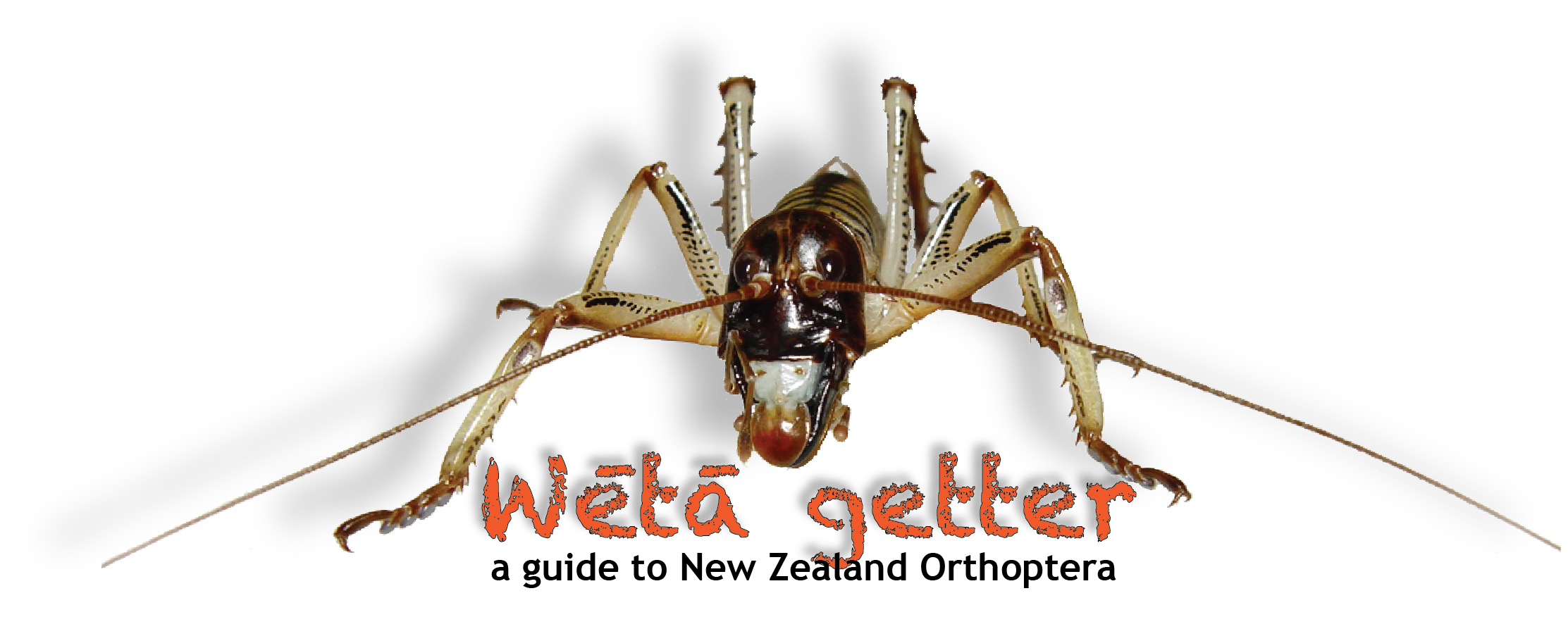 
|
| Pleiopectron rodmorrisi ©Danilo Hegg |
Pleioplectron simplex ©Jim Whitfield |
|
Pleioplectron Hutton, 1897 are small to medium cave weta found in various habitats of North Island and South Island. The genus Weta is asynonym of Pleioplectron (Hegg et al. 2019). Hutton (1899) moved Pleioplectron diversum to Miotopus diversus, although Richards (1959) suggested a return to Pleioplectron. Miotopus has since been resurected (Fitness et al 2018).
|
Pleioplectron simplex Hutton, 1896
A medium-sized cave wētā found in forested and urban areas in the southern South Island, east of the mountains, mainly in inland Canterbury and the east coast. It is very common in highly modified environments, including around dwellings and firewood piles; Pleioplectron simplex is ‘the’ urban cave wētā of New Zealand’s South Island. Chequered grey-brown in colour, often with a prominent yellow median line running along the length of the dorsum. |

|

|
Pleioplectron hudsoni Hutton, 1896
A small brown cave wētā with a yellow median dorsal stripe or band, found in forests throughout the North Island. It lacks a posterior apical spine on the fore femur.
|
 |
 |
Pleioplectron thomsoni (Chopard 1923)
A medium-sized cave wētā with long legs, pale colour, pronotum and tergites glabrous and shiny. It is common and widespread in caves and forests in South Canterbury and Otago. It has prolateral and retrolateral apical spines on both fore and mid femur.
|
 |
 |
Pleioplectron triquestrum Hegg, Morgan-Richards, Trewick 2019.
A small to medium-sized, dark-coloured inhabitant of the forests in the northeast of the South Island. Chequered grey-brown in colour, with visibly banded legs and often with a dorsal median line typical of Pleioplectron and can be mistaken for P. simplex at southern end of its range. |
|
 |
Pleioplectron auratum Hegg, Morgan-Richards, Trewick 2019.
A small to medium-sized cave wētā found in forests and in urban and disturbed habitats in the northeast corner of South Island. Typical of Pleioplectron, colour is chequered grey-brown with visibly banded legs and with a dorsal median line. A prominent pair of longer spines stands out on the hind tibia, about one third of the way up from the apex. Relative to body size, the ovipositor is longer than in any other species of this genus. |
|
 |
Pleioplectron gubernator Hegg, Morgan-Richards, Trewick 2019.
A small inhabitant of the forest floor in the northwest of the South Island. The habitus is typical of Pleioplectron, chequered grey-brown in colour, with visibly banded legs. Very dark all over, with median dorsal line hardly visible.
|
|
 |
Pleioplectron caudatum Hegg, Morgan-Richards, Trewick 2019.
A small inhabitant of the forest floor in the southwestern regions of the South Island of New Zealand. The habitus is typical of Pleioplectron, chequered grey-brown in colour, with banded legs but overall dark and without a median dorsal line. |
|
 |
Pleioplectron flavicorne Hegg, Morgan-Richards, Trewick 2019.
A small inhabitant of the forest floor in the southwestern regions of the South Island. The habitus is typical of Pleioplectron, mottled brown in colour, with visibly banded legs and generally a visible median dorsal line. The species stands out for the yellow colour of the scapes of the antennae. |
|
 |
Pleioplectron chrystallae Hegg, Morgan-Richards, Trewick 2019.
A small cave wētā from the northwestern regions of the South Island, found predominantly near the tree line and in sub-alpine habitats, on the forest floor or on tree trunks, where it feeds on Racomitrium Brid. moss and occasionally on lichens. Unmistakable in its looks, this striking species stands out for its four or five pairs of very long, articulated spines on the hind tibiae, the chevron pattern on its back and a colour that varies from military green to brown and reddish brown. |
|
 |
Pleioplectron rodmorrisi Hegg, Morgan-Richards, Trewick 2019.
A medium-sized cave wētā that inhabits rock bluffs in the sub-alpine and low alpine regions of the Kaikōura Ranges and North Canterbury on South Island, up to an elevation of approximately 1500 m a.s.l. A strikingly beautiful and unmistakeable animal, it stands out for its unusually long legs (especially in the males), red-orange legs and antennae, purple-black back and a bold dorsal yellow median line.
|
|
 |
References:
- Hutton F.W. 1897 The Stenopelmatidae of New Zealand. Transactions and Proceedings of the New Zealand Institute 29: 208-242.
- Hutton F.W. 1899 Supplement to the Stenopelmatidae of New Zealand. Transactions and Proceedings of the New Zealand Institute 31: 40-43.
- Fitness J, Morgan-Richards M, Hegg D, Trewick SA. 2018. Reinstatement of the New Zealand cave wētā genus Miotopus Hutton (Orthoptera: Rhaphidophoridae) and description of a new species. European Journal of Taxonomy #468.
- Hegg D, Morgan-Richards M, Trewick SA. 2019. Diversity and distribution of Pleioplectron Hutton cave wētā (Orthoptera: Rhaphidophoridae: Macropathinae), with synonymy of Weta Chopard and description of seven new species. European Journal of Taxonomy #577
|
|

